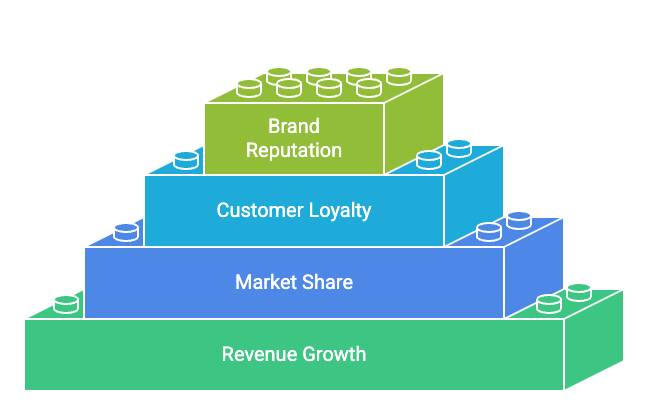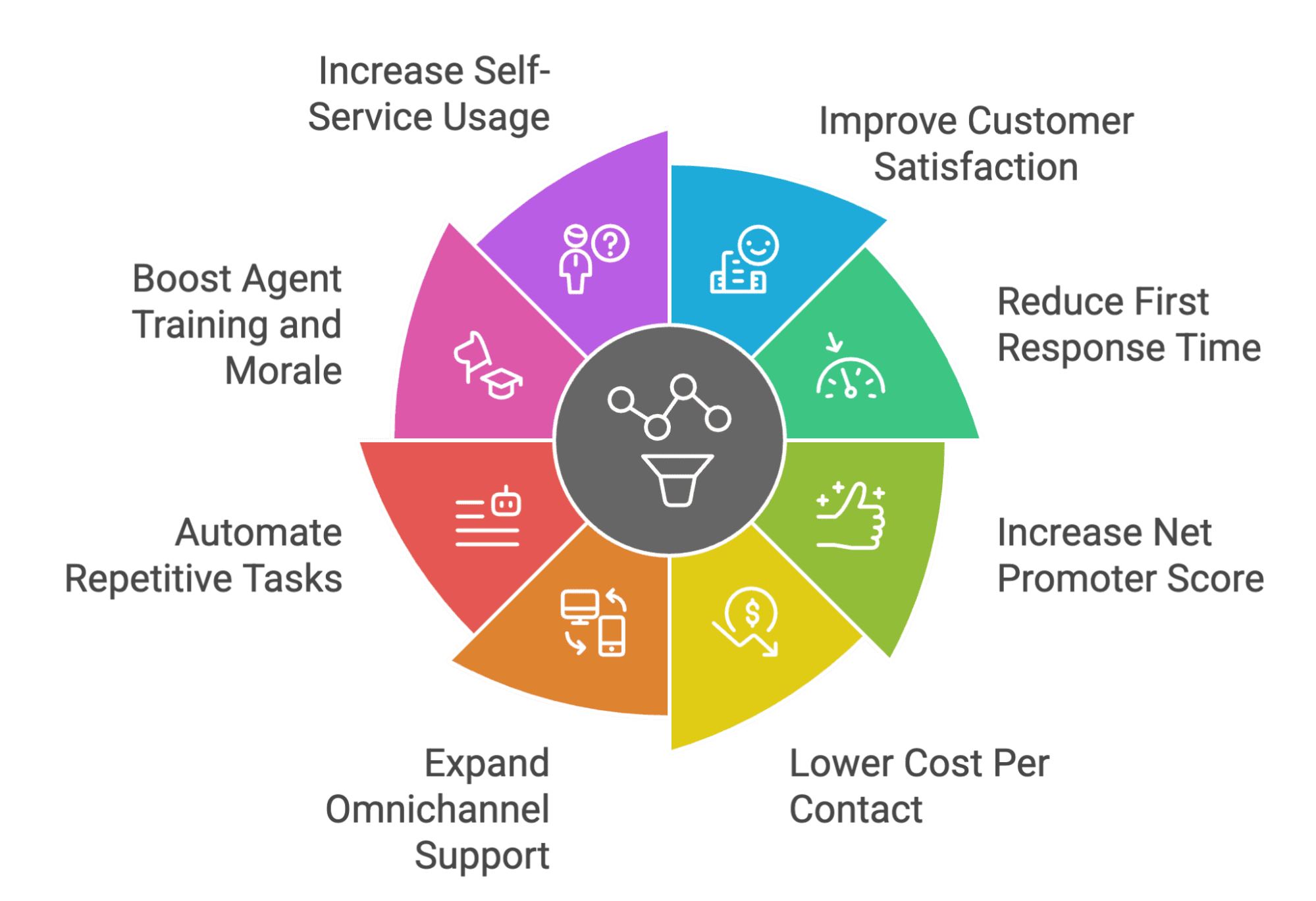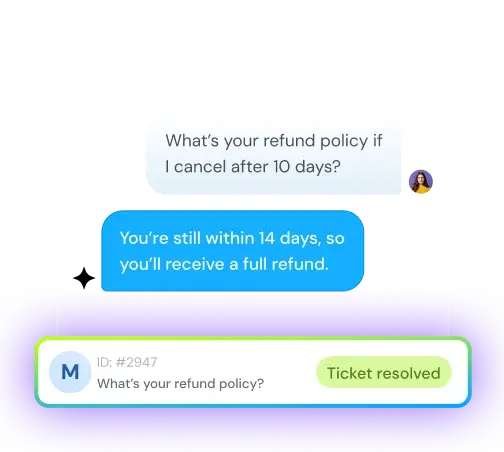Customer service goals that actually work: expert guide for 2025
Vaishali Jayaprakash
Aug 13, 2025

Great customer service goals can reshape your business. Customer service goals are not optional anymore—they determine business survival. Statistics show that 93% of customers are more likely to buy again after receiving excellent service.
Many companies still struggle with what good customer service goals should look like and how to set objectives that drive meaningful results and long-term loyalty.
Why setting customer service goals matters in 2025
Customer expectations are higher than ever in 2025. Nearly, nine in ten Americans make their buying decisions based on the quality of service that they receive, With 66% of customers want companies to understand their specific needs and expectations. One service mistake can make customers four times more likely to choose your competitor. This proves why the right customer service goals are essential to keeping customers.
Your team needs a planned approach to set customer service objectives. Successful teams create measurable targets through SMART frameworks. Your goals should cover every step of the customer's experience.
This piece offers practical, achievable customer service SMART goals that work in 2025. You'll find suitable strategies to set objectives that drive business results. This applies whether you want to improve satisfaction scores, speed up response times, or make use of AI. In fact, 86% CX leaders believe AI will reshape customer experience within three years.
A clear set of objectives for your support team works like a roadmap that leads to success.
Making service match business outcomes
Your customer service goal needs to support wider business priorities since customer support influences every operation. Support efforts should directly contribute to company-wide objectives rather than function separately.
Many organizations make the mistake of creating contact center goals that don't match company priorities. A luxury brand focusing only on cost reduction in customer care could harm its premium experience.

Specific customer experience initiatives tied to these business goals create a unified strategy where each interaction moves your mission forward. Customer service data gives valuable insights about product usage, customer preferences, and potential reasons for switching to competitors.
Keeping up with customer needs
Customer expectations have reached new peaks in 2025. About, 43% of respondents of a research said they were at least somewhat likely to switch brands after only a single negative customer service interaction.
77% of today's customers just need proactive support and 87% need personalized interactions based on their history . 79% of customers expect companies to predict their needs —a trend that will grow stronger in 2025.
Customers compare your service to their best experiences anywhere, not just your competitors. This explains why 30% of consumers believe customer experience has worsened in the last year—expectations are rising faster than businesses can adapt.
Meaningful customer service SMART goals help your team remain competitive against these changing expectations.
Building team consistency
Teams might interpret service standards differently without clear objectives, which confuses customers. Well-laid-out customer service goals solve this by:
- Giving clear direction that removes uncertainty
- Setting specific standards for feedback
- Creating unity across departments
- Helping teams deliver great experiences
Consistency matters because 96% of customers are less loyal after difficult interactions, compared to 9% who have smooth experiences. Goals point everyone in the right direction and promote service quality enhancements through targeted opportunities.
Teams can deliver quality service across phone, email, chat, and social media channels. This reliable experience builds trust and promotes long-term loyalty.
How to set SMART customer service goals
A well-planned approach and method will help you set effective customer service goals. Your team can turn their aspirations into reality with the right framework. The SMART approach—which George T. Doran developed in 1981—gives you a blueprint for achieving meaningful results.

Specific: Define clear outcomes
Vague statements like "improve customer service" won’t work because they lack a clear path. Your customer service goal should convey what you want to achieve. To name just one example, rather than saying "much satisfied customers," you could say "increase CSAT from 60% to 80% within six months by improving agent training and quality of response". This clarity helps your team understand their path and move forward.
You can test your goals by asking key questions: What exactly do you want to achieve? Who will lead this initiative and make it happen? These answers will help you create practical plans from unclear objectives.
Measurable: Use KPIs like CSAT and NPS
Every goal for customer service needs concrete metrics to track progress. Two valuable measurements stand out:
- Customer Satisfaction Score (CSAT): Measures the happiness with support interactions on a 1-5 scale. Ratings of 4-5 is counted as "satisfied"
- Net Promoter Score (NPS): Shows customer loyalty by measuring how likely customers would recommend your business on a 0-10 scale.
CSAT gives quick feedback on specific interactions, while NPS reveals long-term customer relationships. You can calculate CSAT by dividing satisfied customers (4-5 responses) by total respondents and multiplying by 100. For NPS, subtract detractors (0-6) from promoters (9-10).
Achievable: Set realistic targets
Ambition propels development, but unrealistic customer service goals discourage your team. Let's say your AI agent resolves 30% of questions without agent help. A target of 40% over two quarters makes sense. But aiming for "100% customer happiness" sets everyone up to fail.
Ask yourself these questions to check if goals are achievable: Do you have the core team? Does your budget cover everything? Does your team know what they're doing? Attainable goals build confidence and motivation—a University of Basel study showed that reachable objectives boost personal well-being.
Relevant: Line up with company mission
Your customer service SMART goals should connect to your broader business strategy. Goals about response time and personalization make sense if your company values quick, friendly support. If you focus on affordability, better self-service options might work better.
Gather common rep goals, learn about customer pain points through surveys and feedback, and explain how each goal supports company strategy. This connection gives your team a shared purpose and shows that customers come first.
Time-bound: Set deadlines and milestones
Goals need deadlines to create urgency and accountability. Smaller time-bound checkpoints help you track progress. To name just one example, if you want to launch omnichannel support, create monthly targets: pick your top three channels in month one, train agents in month two, and launch the first channel in month three.
Short-term goals boost team spirit as people see quick results. A rep who handles 50 issues weekly could aim for 55—just one more each day. These small wins build confidence steadily.
8 Customer service goals that actually work
Let's look at eight customer service goals that bring tangible results to innovative organizations.

1. Improve customer satisfaction (CSAT)
A specific CSAT target helps your team deliver consistently excellent experiences. To cite an instance, you might want to "increase customer satisfaction from 82% to 87% in the next three months". This clear goal helps teams make service quality their priority and enhances the overall customer experience. Most customer service platforms come with built-in CSAT survey capabilities that measure progress reliably.
Quick tip: Part of improving satisfaction is being ready to respond quickly to difficult situations. Knowing how to resolve conflicts and angry customer cases quickly ensures frustrated customers leave satisfied, turning challenges into loyalty.
2. Reduce first response time (FRT)
Rapid answers are what customers value the most in their experience. Your team could target "decreased average first reply time for email from 11 hours to 8 hours by November 30th". Success requires dedicated agents who treat conversations immediately, proper staffing levels using appropriate tools. Different types of channels need different measurement approaches—like a phone support needs holding time metrics, whereas, digital channels should focus on first reply times.
3. Increase net promoter score (NPS)
NPS shows your brand's relationship with customers more thoroughly than CSAT. Your target might be to "increase quarterly NPS from 80 to 90 before the end of Q4". A better NPS usually leads to improvements in other metrics, showing what resonates with customers effectively.
4. Lower cost per contact (CPC)
The right balance between customer support and cost management makes a difference. A realistic goal would be: "reduce cost per contact by 10% for free plan users by the end of Q1". The total support costs divided by contact numbers give you CPC. Budget-friendly channels, better self-service options, and streamlined resolution processes can help reduce CPC.
5. Expand omnichannel support
Your strategy should put customers first, especially since 86% expect uninterrupted transitions between channels. The key lies in connecting email, SMS, live chat, and phone into one system where conversations stay consistent whatever the channel.
6. Automate repetitive tasks
The goal could be to "resolve 30% of customer issues automatically in Q4". AI agents can handle easy and simple questions and provide continuous support while allowing agents to address complex issues. This approach reduces the costs and lets your team focus on more meaningful interactions instead of simple FAQs.
7. Boost agent training and morale
Your bottom line benefits directly from investing in your team's development. Regular training sessions can improve product knowledge, communication abilities, and service excellence. New technologies and best practices covered in skill development sessions help lift service quality significantly.
8. Increase self-service usage
Self-service tools appeal to customers—67% would rather find answers themselves than talk to representatives. A user-friendly knowledge base, FAQ pages, and community forums should be easy to find. This approach reduces support costs while making customers who prefer independence happier.
How to track and measure your goals
Tracking customer service goals means something more than just gathering numbers. You need to turn your data into meaningful insights that make your service better. The best objectives become pointless without proper measurement.
Choosing the right metrics
Your measurement strategy starts with picking KPIs that show how well you meet your service goals. Customer satisfaction score (CSAT) and Net Promoter Score (NPS) tell you what customers think about your service and how loyal they are. Customer Effort Score (CES) shows how smooth your customer interactions are.
The operational side needs attention too. Your team's first response time shows how quickly they handle customer questions. Each channel has its own target: 24 hours for email, 60 minutes for social media, 3 minutes for phone, and instant for live chat. The overall resolution rate helps identify service bottlenecks by examining total tickets to solved ones.
Using dashboards and analytics tools
Good visualization helps you make sense of raw data. Customer support tools provide robust dashboards and analytics that put your important metrics front and center. They give you clear views of ticket queues, agent availability, and how well operations run. Look for these features in your analytics tools:
- Compatibility and integration with your current customer service platforms
- Immediate data tracking to spot service issues quickly
- Complete analytics with trend analysis capabilities
- Accessible interfaces that everyone can use
- Scalability as your business grows
Pre-built dashboards give you quick metric overviews that provide instant insights without much setup. Teams can also customize their views based on specific needs.
Setting up regular performance reviews
Create a structured schedule for reviews - weekly or monthly - that looks at specific metrics like response times, satisfaction rates, or how well you meet SLAs. These targeted evaluations help you catch problems early and optimize workflows.
Your reviews should dig deep into customer data to create personalized service strategies. Ask agents to evaluate their own work and reflect on what they learned over time. This two-way approach leads to better performance discussions and keeps everyone working toward team goals.
Common mistakes to avoid when setting goals
Even well-meaning organizations stumble when creating customer service goals. You can strengthen your customer experience strategy by learning about these common pitfalls.
Setting vague or unrealistic goals
Teams cannot implement vague goals like "improve customer service". They lack clear direction and waste time on mismatched efforts. Your goals need specific targets—for example, "increase customer satisfaction scores by 10% within the next quarter by implementing a new feedback system".
Realistic goals prevent burnout and disappointment while encouraging team morale. Research shows ambitious targets can demotivate your team and lead to high turnover. You should challenge your team without overwhelming them.
Ignoring frontline feedback
Frontline employees have ground insights into their roles' challenges and opportunities. Getting them involved in goal-setting boosts engagement and accountability. Research shows employee motivation increases by a lot when they help set their own goals.
Customer service representatives know customer pain points firsthand. Their input is vital to determine what matters most to your audience. You need well-laid-out processes that turn frontline feedback into strategic actions.
Failing to adjust based on data
Goals should adapt in today's ever-changing environment. Regular timeline reviews will keep progress on track. Goals become unreachable dreams without consistent monitoring.
Your metrics and KPIs should match your strategic plan. Regular review meetings help assess progress and make analytical decisions about future actions. This flexibility in goal planning becomes more important as circumstances change.
Conclusion
Setting the right customer service goals is crucial for business success. This piece shows you how well-laid-out objectives can turn unclear ideas into results you can measure. So your team knows exactly what to do, and your customers get great service every time.
Note that customer expectations keep rising each year. But SMART goals give you what you need to tackle these challenges directly. Specific targets like "improve CSAT by 10% within six months" work better than vague wishes like "make customers happier."
Eight practical goals we discussed - from better satisfaction scores to wider omnichannel support - can guide you toward outstanding service. On top of that, these goals help drive more revenue, build a stronger brand, and keep customers coming back.
Your frontline agents know things that can substantially improve how you set goals. Make sure to include their point of view when you create objectives and check progress with everyone on your team. You should adjust your approach based on actual performance data rather than guessing.
Great customer service doesn't just happen. It comes from careful planning, measuring results, and always making things better. You now have everything you need to create meaningful objectives that work. What customer service goal will you tackle first?
Quick summary: customer service goals that actually work (2025 expert guide)
- Customer service goals are essential for business success—93% of customers return after excellent service, and many will switch to competitors after a single bad experience.
- Customer expectations are higher than ever in 2025. Personalized, seamless, and proactive service is expected across all channels, and customer service quality heavily influences loyalty and business choice.
- SMART goals (Specific, Measurable, Achievable, Relevant, Time-bound) are the gold standard for effective goal-setting, e.g., "Increase CSAT from 82% to 87% in three months."
- Eight proven customer service goals:
- Improve customer satisfaction (CSAT)
- Reduce first response time (FRT)
- Increase Net Promoter Score (NPS)
- Lower cost per contact (CPC)
- Expand omnichannel support
- Automate repetitive tasks with AI
- Boost agent training and morale
- Increase self-service usage.
- Tracking and measuring progress is critical: Use dashboards, regular performance reviews, and relevant KPIs (CSAT, NPS, CES, FRT).
- Common mistakes to avoid: Setting vague/unrealistic goals, ignoring frontline input, and not adapting goals as data or business needs change.
- Key advice: Involve frontline agents in goal-setting, review progress often, and adjust goals based on real-world results. Well-designed customer service goals drive better loyalty, efficiency, and business growth.
Frequently Asked Questions
SMART customer service goals are Specific, Measurable, Achievable, Relevant, and Time-bound objectives that help teams focus on delivering exceptional customer experiences. They provide clear direction and allow for effective tracking of progress.
To improve customer satisfaction scores, focus on reducing response times, providing personalized service, expanding omnichannel support, and investing in agent training. Set specific targets, such as increasing CSAT from 82% to 87% within three months, and regularly measure progress.
Frontline employees have valuable insights into customer pain points and practical challenges. Involving them in the goal-setting process increases engagement, accountability, and intrinsic motivation. Their input helps create more realistic and effective customer service objectives.
Customer service goals should be reviewed regularly, typically on a weekly or monthly basis. This allows teams to track progress, identify issues early, and make necessary adjustments based on real performance data. Regular reviews ensure goals remain relevant and achievable in a fast-paced environment.
Common mistakes include setting vague or unrealistic goals, ignoring frontline feedback, and failing to adjust based on data. Avoid generic objectives like "improve customer service" and instead focus on specific, measurable targets. Regularly review and adapt goals based on performance metrics and changing circumstances.
Here are some good customer service goals that genuinely move the needle:
1. Reduce First Response Time
Customers expect fast replies. A realistic goal is to cut your average first response time by 20–40%.
2. Improve CSAT Scores
Aim to increase customer satisfaction by consistently collecting feedback and resolving recurring issues.
3. Boost First Contact Resolution (FCR)
Resolve more issues in the first interaction. This reduces workload and instantly improves customer experience.
4. Strengthen Knowledge Base Usage
Set a goal to help customers self-serve more by improving documentation and tracking views/deflection.
5. Enhance Agent Productivity
Use automation, templates, and workflows so agents handle more tickets without burning out.
6. Reduce Ticket Backlogs
Set weekly or monthly backlog targets to keep support clean and manageable.
7. Increase Customer Retention
Tie support performance directly to retention metrics — happy customers stay longer.
8. Improve SLA Compliance
Meeting promised timelines builds trust. Target 90–95% SLA compliance.
